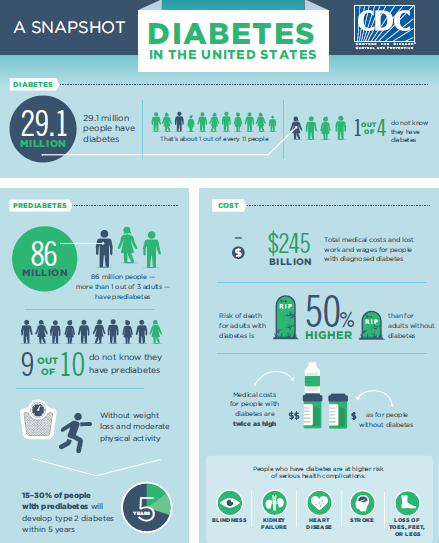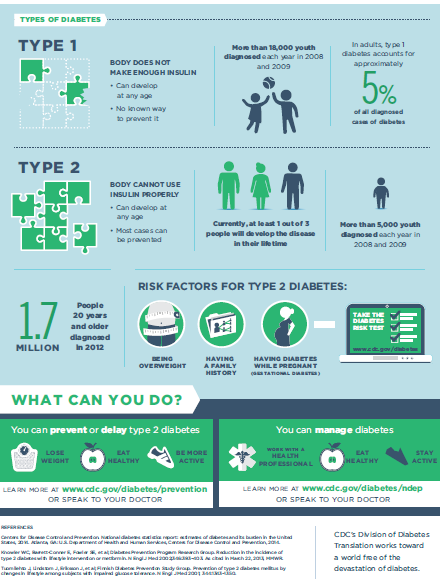
American Diabetes Month
By Maggie Perkins, Senior Nutrition Health Educator
At the Poe Center, health educators teach children, youth, and families about lifestyle diseases and prevention. For younger groups, we identify some lifestyle diseases (some types of cancer, heart disease, and stroke) and for older groups, we dive into the mechanics and prevention of these disease states. Students in lower elementary classes usually have heard the word “diabetes” and associate it will an illness. But many people find the topic of diabetes confusing because there are multiple types, and the prevention and treatment for each is different.
Before we talk about the types of diabetes, let’s explore some of the words used to talk about the differences. When we eat a meal, the food is broken down into very small pieces. The body absorbs the nutrients from our food and uses carbohydrates, fat, and protein for energy. Glucose is a carbohydrate that fuels our body and our brain. Once the glucose is absorbed from the food we eat, it is dumped into the bloodstream and sent to all of the cells of the body to be used as energy. When the glucose is released in our blood, the pancreas releases insulin. Think of insulin like a key that “unlocks” the cells and allows the blood glucose to enter the cell. Both type I and type II diabetes cause this system to be disrupted. One of two things can happen: the insulin doesn’t work properly or the insulin does not exist. If the glucose can’t get into the cell, then blood sugar is going to remain high. Having high blood sugar makes the blood thick (think of syrup) and damages the vessels and tissues of the body.
Type I diabetes is genetic. A type I diabetic doesn’t produce insulin. A person with type I diabetes is insulin-dependent and will use insulin injections or an insulin pump to regulate blood sugar.
Type II diabetes is considered a lifestyle disease. Living a sedentary lifestyle, smoking, consistently eating junk foods, and being overweight put you at a much greater risk of getting type II diabetes. With type II diabetes, the body is producing insulin but the insulin doesn’t work well or the body is not producing enough. Treatment may include insulin injections, oral medications, and adopting a healthier lifestyle. Type II diabetes is the most common type of diabetes and accounts for 95% of all diagnoses.
Gestational diabetes occurs when a woman experiences consistent, high blood sugar during pregnancy because of hormonal changes. For the majority of women who get gestational diabetes, blood sugar normalizes after the baby is born, but it does put the mom at greater risk of getting type II diabetes later in life.
It is becoming more common for children to get diagnosed with type II diabetes. This correlates with our country’s unhealthy habits and the obesity epidemic. But don’t fret, type II diabetes may be prevented by maintaining a healthy weight, eating nutrient-rich foods, and being physically active. For healthy eating, follow these USDA MyPlate messages for each food group:
- Go lean with protein: choose low fat varieties, e.g. at least 90% lean ground beef, skinless poultry, round steaks and roasts, and beans
- Vary your veggies: choose different types and colors of vegetables
- Focus on Fruits: make sure fruit is on your plate at every meal
- Make half your grains whole: choose 100% whole grain products, e.g. 100% whole wheat bread, brown rice, and oatmeal
- Choose calcium rich foods: choose low-fat dairy foods like reduced-fat cheese and skim or 1% milk
And remember: no one is perfect, and less healthy foods are going to sneak their way into our lives either by being presented to us as gifts, at holiday parties, treats at school or work, etc. Don’t beat yourself up if you have a less healthy food every now and then. We call these less healthy foods (containing high amounts of sugar, fat, and/or salt) “sometimes foods” at the Poe Center. The key is moderation with these types of foods. We will and should enjoy a “sometimes food” once in a while. But don’t forget to ENJOY it! Slow down and pay attention to the taste and texture of the food.
If you are interesting in learning more about living a healthier lifestyle check out the Poe Center for Health Education’s nutrition programming at
http://www.poehealth.org/educational-topics/nutrition-physical-activity/.
http://www.diabetes.org/diabetes-basics/genetics-of-diabetes.html
http://www.mayoclinic.org/diseases-conditions/diabetes/expert-blog/types-of-diabetes/bgp-20056516


